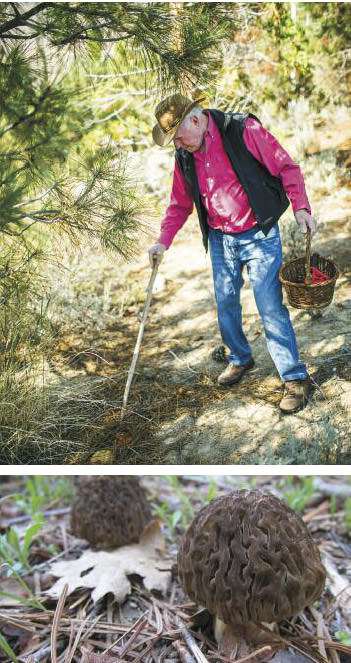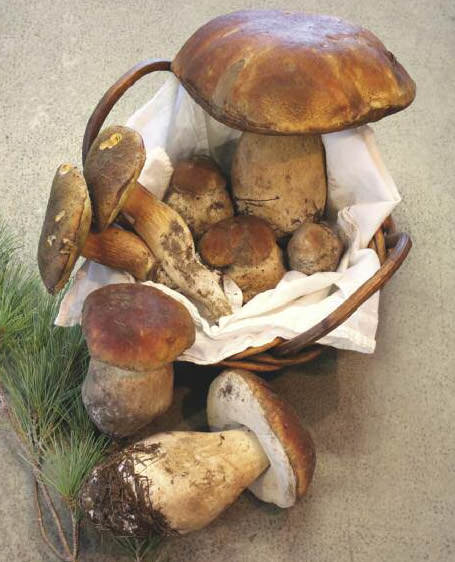feature
FINDING FUNGI
Locals hunt for treasures in the woods.
WRITTEN BY ERIN MEYERING
PHOTOS BY JACI GOODMAN, JAMIE KINGHAM, AND HANK SHAW
There’s much more growing in the forest than trees.
Zeny Ocean, a Reno dentist, says you might just find the longtime forager’s specialty: wild mushrooms. And cooking with wild mushrooms, he says, if properly identified and found to be safe to consume, can be a rewarding adventure.
“Wild mushrooms have an intense, woodsy, smoky flavor,” Ocean says.
He and his wife Janis create mushroom stews, tarts, soups, and countless other dishes from their foraged finds.
Another avid local forager, Hannes Lamprecht, co-owner of Way to Go travel store in Reno, learned the hobby from his grandparents and parents while growing up in Austria. He says the selection of mushrooms in this area is quite good and comparable to that in Austria.
Cooking chanterelles with salmon and a tangy citrus sauce is his ideal way to serve wild mushrooms.
Safety first
 Of the utmost importance in hunting for wild mushrooms is being extremely careful with identification.
Of the utmost importance in hunting for wild mushrooms is being extremely careful with identification.
“I don’t take any risks [consuming mushrooms I can’t easily identify],” Lamprecht says.
Ocean shares a memory of taking his daughter, Kaity, foraging. He thought he had seen a large, green puffball mushroom and excitedly pointed it out to his daughter. Upon closer inspection, Kaity figured out that the amazing mushroom Ocean thought he had found was, in fact, just an old tennis ball.
Hank Shaw, a Reno-Tahoe area foraging expert and author of last year’s Duck, Duck, Goose: The Ultimate Guide to Cooking Waterfowl, Both Farmed and Wild Hunt, forages for mushrooms and many other wild edibles in the Sierra Nevada (see related story in this issue). In his first book (Hunt, Gather, Cook: Finding the Forgotten Feast) and on his website (http://www.Honest-food.net), he offers tips for harvesting mushrooms, including what to look for and how to cook what you find. (See his recipe below for Red Wine Wild Mushroom Ragù.)
Various mushrooms can be found locally at different times of the year. What is available depends on consistent temperatures and moisture. Thus, a consistently wet winter, with moderate rainfall, is an indicator that it will be a good mushroom-hunting year.
In the fall, Shaw recommends that foragers watch for porcinis. Spring and early summer can be great times to find local wild morels, shaggy manes, white chanterelles, and slippery jacks.
Venturing out on a search for wild mushrooms can be exciting. It allows you to take in your natural surroundings and even plan your next dinner.
Erin Meyering is a mushroom lover and consumer, but she has never foraged for her own. With the resources provided in this story, and the oh-so-tempting recipe, she now may do so. She believes there is no better, more homier dish than savory pasta with mushrooms and cream sauce.
Resources
• Our sources agree that taking an experienced forager with you on your first few mushroom-hunting trips can be extremely useful. It’s important to have someone help identify and search for edibles so that you don’t mistakenly consume dangerous look-alikes.
• For great, detailed information on wild mushrooms, check out David Arora’s books Mushrooms Demystified and All that the Rain Promises and More: A Hip Pocket Guide to Western Mushrooms. For details, visit http//www.Davidarora.com
• The Way to Go travel store in Reno hosts an annual, culinary-focused trip to Austria, which partially focuses on mushroom hunting. For details, visit http//www.Waytogoreno.com
Recipes
Red Wine Wild Mushroom Ragù
(courtesy of Hank Shaw and his website, Honest-food.net. Serves 8 to 10)
This is intended to be created with locally sourced or foraged mushrooms and acorns. The acorn pasta recipe can be found online at Honest-food.net.
A note on the mushrooms: If you are not a forager and are buying dried mushrooms in the store, the standard half-ounce package you see in the produce section will be a good substitute for the foraged “handful.” You also can buy all kinds of fresh and dried mushrooms online at Earthy.com.
About 2 to 3 ounces dried mushrooms (porcini, morel, chanterelle, black trumpet, matsutake, maitake, oyster, etc.)
3 tablespoons duck fat, butter, or olive oil
¼ pound thick bacon, cut into ½-inch chunks
1 onion, finely chopped
4 garlic cloves, finely chopped
2 tablespoons tomato paste
2 cups red wine
1 tablespoon dried oregano
1 to 3 cups hot water for soaking mushrooms
Sprig fresh oregano
Black pepper
Grated hard cheese, such as Parmesan or pecorino, for garnish
Put mushrooms in large bowl and fill with hot tap water until covered. Let soak for at least 30 minutes and up to several hours, depending on how large or old mushrooms are (larger and older mushrooms may take longer to rehydrate). Remove mushrooms once they’ve rehydrated and rinse them; save and set aside soaking water. Put mushrooms in tea towel, wrap up, and squeeze dry. Chop mushrooms and set aside.
Slowly strain brown, mushroom-soaking water through fine sieve with cheesecloth set inside. Discard final few tablespoons of liquid, which will be full of bits. Remove all grit.
In Dutch oven or other large pot with lid, heat duck fat, butter, or oil over medium heat. Add bacon and fry gently until crispy. Remove bacon and add onions, turning up heat to medium-high. Stir and cook until onions begin to brown. Add garlic and mushrooms and stir well. Cook 3 to 4 minutes, stirring often, until you begin to see garlic starts to brown. Return bacon to pot, add tomato paste, and stir well. Cook 1 minute.
Pour in red wine and add oregano. Stir well and bring to a strong boil. Cook down for 5 minutes. Add mushroom liquid up to level of mushrooms for a loose stew rather than a soup consistency. Taste for salt and add if needed. Let simmer (not boil) until liquid reduces and begins to tighten, about 20 minutes. Cover and turn heat to low. Cook for 1 hour.
Prepare and boil water for pasta. Cook and drain pasta.
To serve, mix some ragù with pasta and top with more sauce. Garnish with chopped fresh oregano, freshly ground black pepper, and grated cheese.


